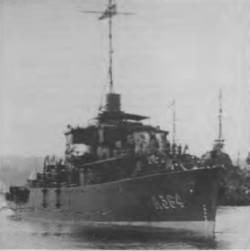- Author
- Thomson, Max
- Subjects
- Ship histories and stories
- Tags
-
- RAN Ships
- HMAS Diamantina I
- Publication
- December 1989 edition of the Naval Historical Review (all rights reserved)
Almost 10 years after decommissioning as a unit of the fleet, of the Queensland Maritime Museum, the River-class frigate HMAS DIAMANTINA, launched in 1944, capped its wartime and post-war career by becoming the most popular ship in the Royal Australian Navy.
Standing in South Brisbane dry dock as the centerpiece of the Queensland Maritime Museum, HMAS DIAMANTINA was part and parcel of Brisbane’s highly-successful EXPO 88.

More than 70,000 of the visitors to EXPO took the opportunity to go aboard HMAS DIAMANTINA and inspect the frigate from stem to stem. Hosted by a volunteer ‘ship’s company’ of guides who wore a specially-devised ‘rig of the day’ for EXPO, the visitors wandered through the frigate’s messdecks, engine room, galley, officers’ cabins, sick bay, wardroom, charthouse, wheelhouse, bridge and other attractions, so many of which housed special Navy displays and historic memorabilia.
DIAMANTINA’s EXPO log book indicated the some 8,000 former Navy men were among the 70,000 who trod its decks again and who signed their names in the log.
Flag officers of the United States Navy, Royal Navy and our own RAN headed a list of distinguished Navy men, many of whom were from visiting warships of the world that came to our shores to take part in the Bicentennial celebrations. Plus men and women from ships that had been part of the First Fleet Re-enactment voyage.
One German sailor who had seen service in the North Atlantic during WW II succinctly summed up the interest of so many when he remarked: ‘I just wanted to see how men from another navy, but from my own generation, once lived’.
Equally fascinated were so many sailors currently serving in our own RAN ships who were keen to see the lifestyle of their counterparts on a WWII warship. They were amazed at the changes that have taken place, especially after guides explained that by night at sea during the war all scuttles were closed and deadlights clamped tightly as the ships maintained complete and utter blackout with only the fairly primitive forced draught ventilation available in those days giving the crew some measure of relief from the heat.
Quaintest question of all, however, was frequently fired to guides in the wheelhouse beneath the ship’s compass platform and bridge. ‘How can you steer the ship when you just cannot see where you are going?’ A fair enough question until guides pointed out the unique periscope in front of the wheel which provided the answer, coupled with the fact that all instructions for ‘conning’ the frigate came down the voice pipe from the bridge above. (Ed. The compass is what you steer by normally.)
Greatest satisfaction of all, for some guides, was in hosting aboard a blind visitor. He went right through the frigate, clambering up and down ladders and into the engine room, touching everything he could and listening intently to detailed descriptions of how things worked.
Nor was it all without moments of humour. People of all shapes and sizes were among the 70,000 visitors – yielding all the customary problems for ladies with high-heeled shoes (and short skirts). But one plump lady got stuck in the ladder leading up to the bridge from the wheelhouse. Sailors being what they are, a couple of ex-matelot guides were tempted to suggest a hat pin vigorously applied would solve the situation, but honour and Navy public relations prestige applied and the problem was solved tactfully.
On that subject, though, many a visitor bumped a head on various parts of the warship’s steelworks – sufficient for the guides to wonder if today’s Australians are somewhat taller than those of yesteryear, especially when several teenagers asked the question, ‘Did you have to be a shorty to join the wartime RAN?
It was a ‘moment for a Mintie’ as one guide quietly observed a Japanese visitor studying the wording of the Japanese surrender document on display in the ship, plus memorabilia that told how the Japanese surrender of forces at Nauru, Ocean Island and at Bougainville was actually signed on board HMAS DIAMANTINA. ‘Inevitably, he was completely inscrutable as he read every word of it,’ said the guide.
The ‘DIAMANTINA Room’ aboard the frigate was among the most popular sections, with its exhibits of the frigate’s history; also the displays that depicted sister-frigates HMA Ships Hawkesbury, Gascoyne, Barcoo, Burdekin, Lachlan, Barwon, Macquarie, Condamine, Murchison, Culgoa and Shoalhaven.




